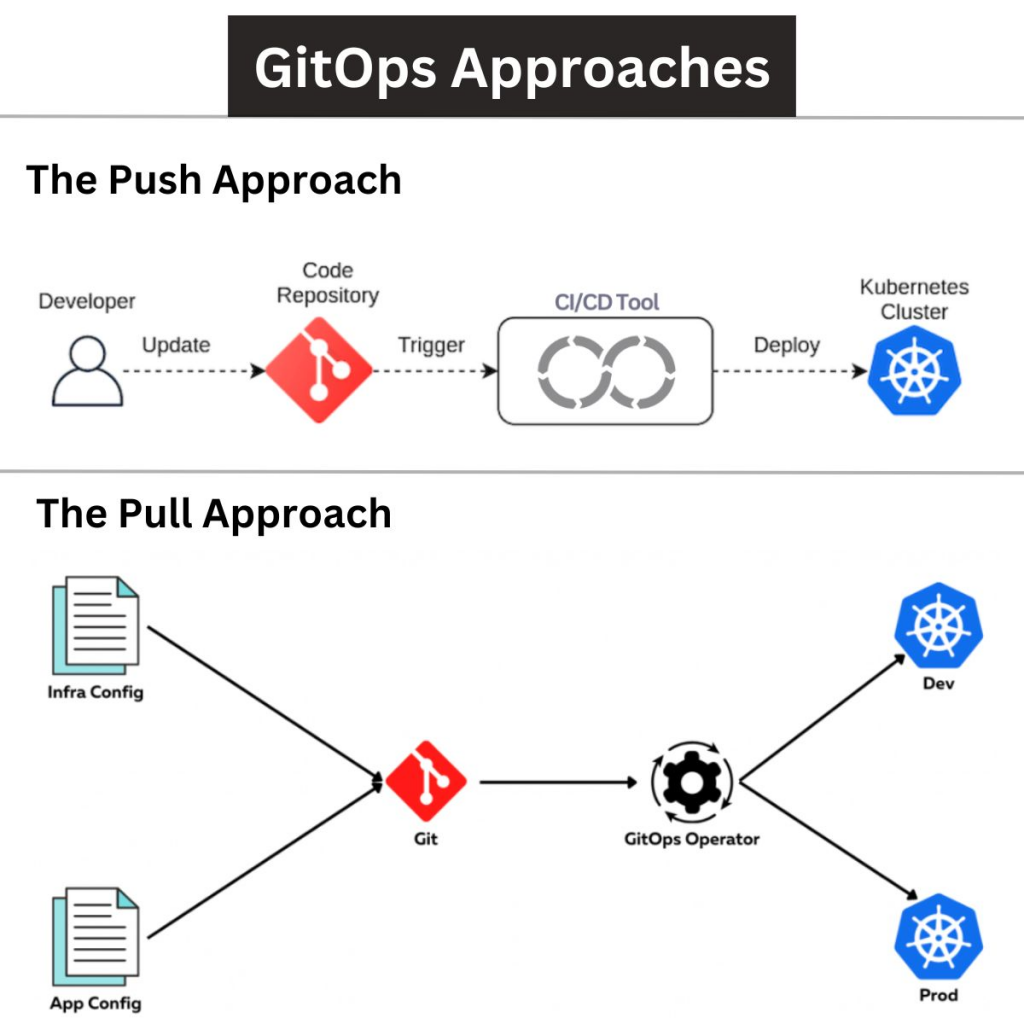
GitOps is revolutionizing the software industry with its powerful and efficient approach to managing and deploying applications. By leveraging the familiar and robust Git version control system, organizations can achieve remarkable speed, reliability, and scalability benefits.
There are basically two GitOps approaches.

This is more closer to your classic CD pipeline approach that is automated. Whenever a change happens in the Git repo, the CD pipeline triggers and pushes the changes to the target environment.

The pull approach has become a standard approach where tools like ArgoCD are used. Here, an agent keeps track of the changes happening in your Git repo, the desired state, and it automatically pulls changes to match the actual state of the system.
In the GitOps approach, there are two different approaches for deploying and managing infrastructure and application configurations: “pull-based” and “push-based.” Let’s explore the differences between these approaches:
- Pull-based approach:
- In the pull-based approach, the desired state of the system is stored in a Git repository.
- A GitOps operator, such as Flux or Argo CD, continuously monitors the Git repository for changes.
- When changes are detected, the operator pulls the updated configuration from the Git repository and applies it to the target environment.
- This approach follows the declarative model, where the desired state is defined and stored in version-controlled Git repositories.
- It enables a self-service model where developers or operators can make changes to the configuration by simply updating the Git repository.
- Push-based approach:
- In the push-based approach, configuration changes are pushed directly to the target environment.
- Changes can be pushed using various deployment tools, scripts, or automation systems.
- The push-based approach is more commonly associated with traditional deployment methods, where changes are manually pushed to the target environment.
- It typically requires direct access to the target environment and may involve manual steps or custom automation scripts.
- This approach is often less predictable and harder to audit compared to the pull-based approach.
Key considerations for choosing between pull-based and push-based approaches in GitOps include:
- Control and Governance: Pull-based GitOps provides better control and governance since all changes go through the Git repository, allowing for version control, code reviews, and traceability.
- Auditing and Compliance: Pull-based GitOps enables easier auditing and compliance by having a complete history of all changes made to the Git repository.
- Consistency and Reproducibility: Pull-based GitOps ensures consistent and reproducible deployments by relying on a single source of truth (the Git repository) for the desired state.
- Automation and Self-Service: Pull-based GitOps allows for more automation and self-service capabilities as developers or operators can update the Git repository to trigger deployments.
- Operational Simplicity: Push-based approaches may be simpler for smaller environments or ad hoc changes but can become complex and error-prone as the system scales.
I’m a DevOps/SRE/DevSecOps/Cloud Expert passionate about sharing knowledge and experiences. I am working at Cotocus. I blog tech insights at DevOps School, travel stories at Holiday Landmark, stock market tips at Stocks Mantra, health and fitness guidance at My Medic Plus, product reviews at I reviewed , and SEO strategies at Wizbrand.
Please find my social handles as below;
Rajesh Kumar Personal Website
Rajesh Kumar at YOUTUBE
Rajesh Kumar at INSTAGRAM
Rajesh Kumar at X
Rajesh Kumar at FACEBOOK
Rajesh Kumar at LINKEDIN
Rajesh Kumar at PINTEREST
Rajesh Kumar at QUORA
Rajesh Kumar at WIZBRAND

 Starting: 1st of Every Month
Starting: 1st of Every Month  +91 8409492687
+91 8409492687  Contact@DevOpsSchool.com
Contact@DevOpsSchool.com
